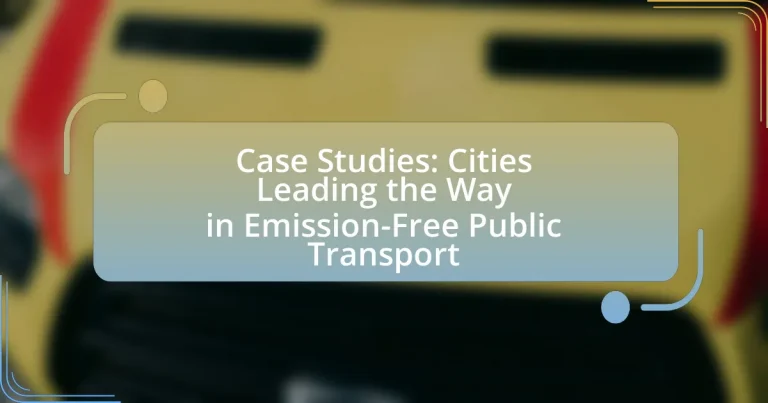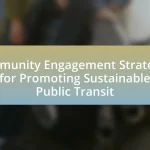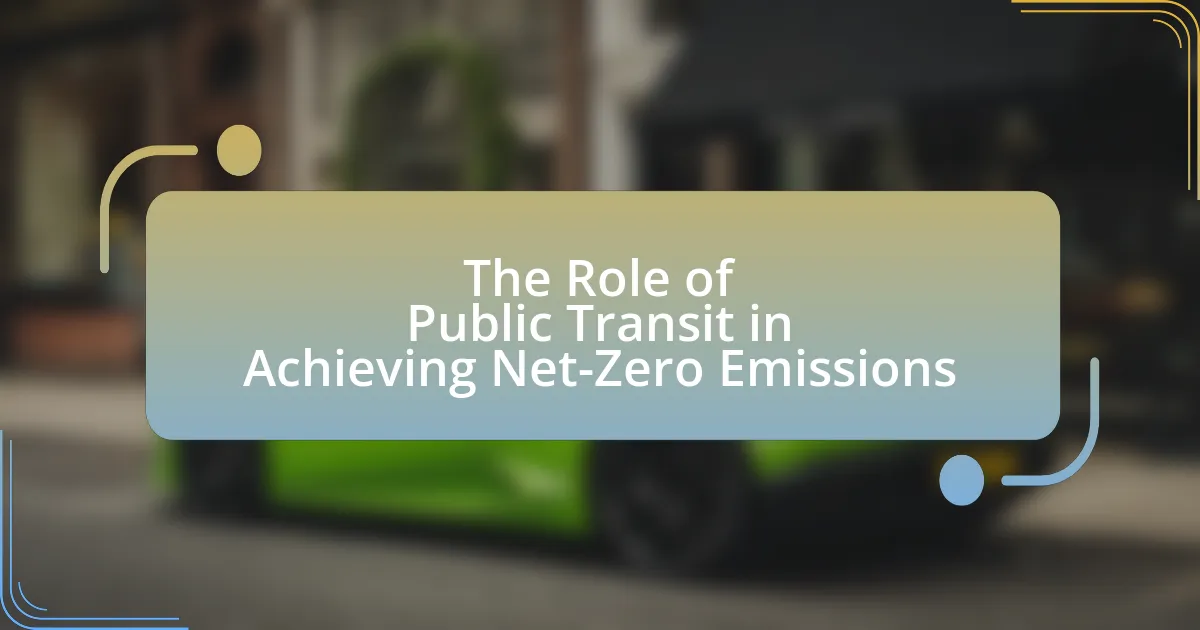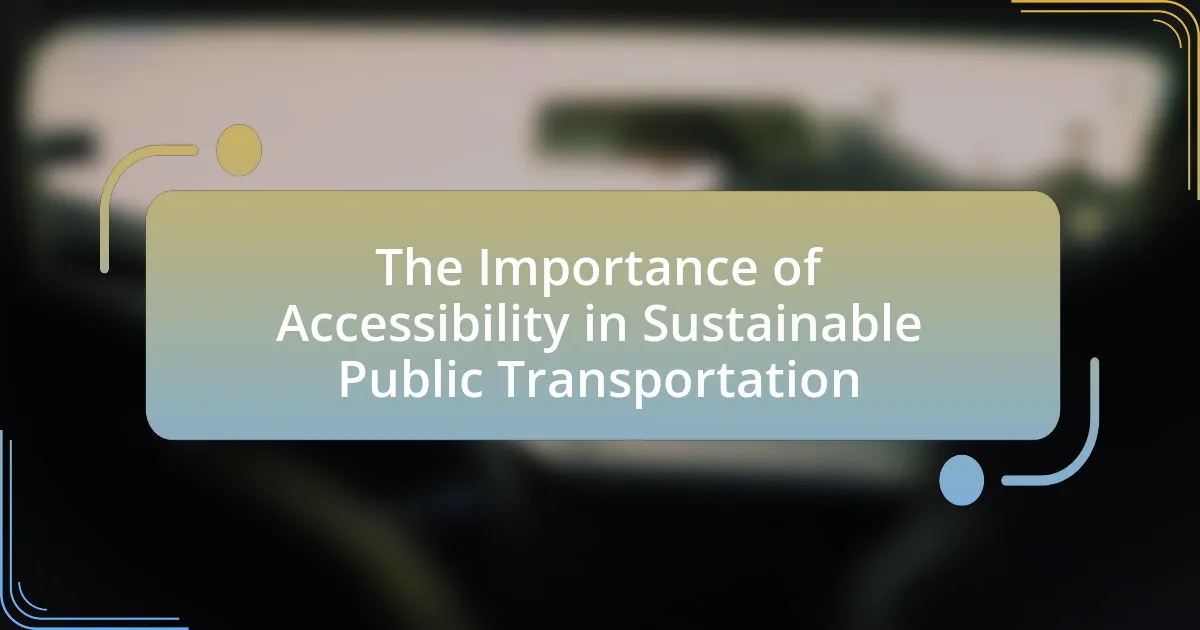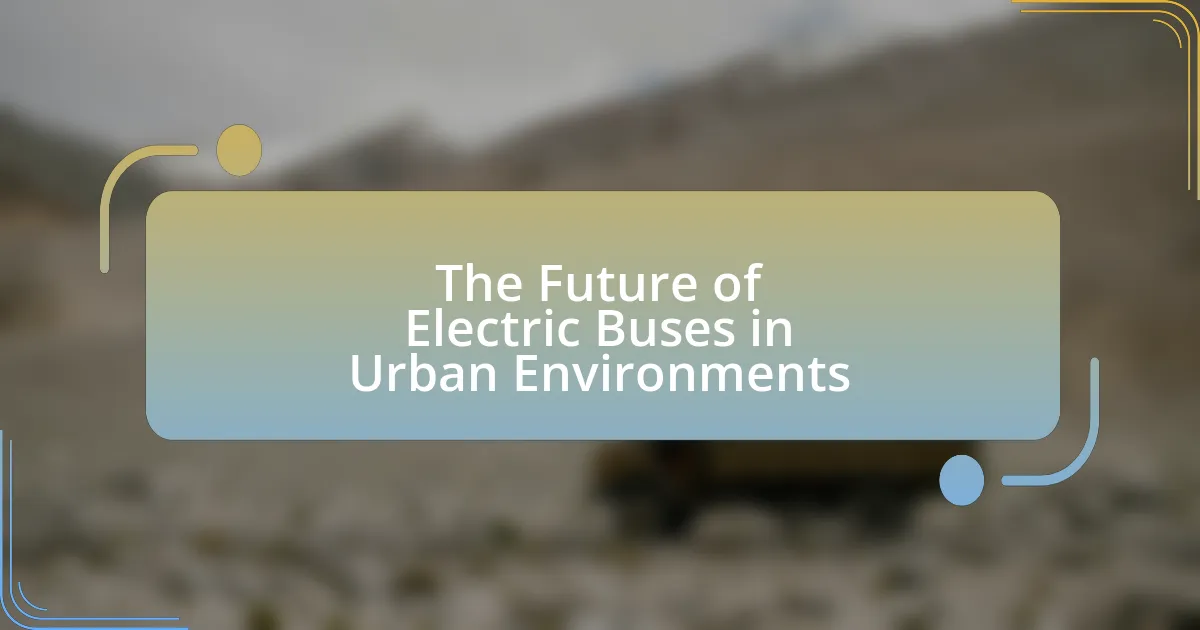The article focuses on case studies of cities that are leading the way in emission-free public transport, highlighting key characteristics such as the use of zero-emission vehicles, renewable energy sources, and efficient route planning. It examines how cities define emission-free transport, the technologies involved, and the environmental benefits associated with these systems. Additionally, the article discusses the challenges cities face in implementing these initiatives, financial barriers, and the importance of public perception and community engagement. Successful examples from cities like Oslo, Shenzhen, and Amsterdam illustrate effective strategies and best practices for transitioning to sustainable urban mobility.
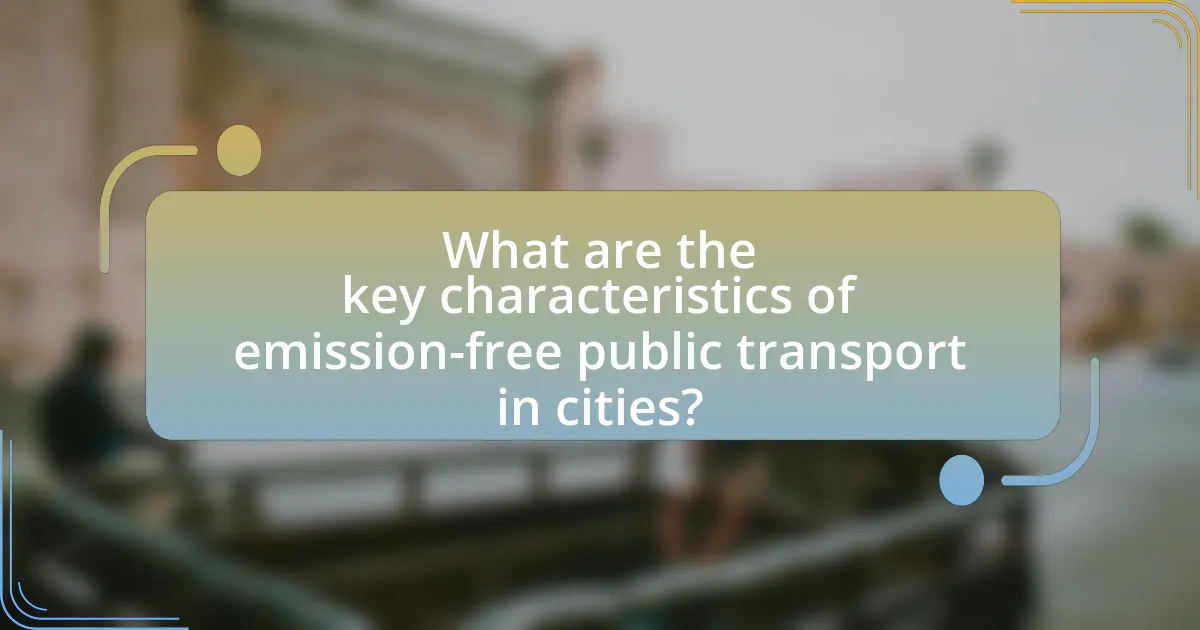
What are the key characteristics of emission-free public transport in cities?
Emission-free public transport in cities is characterized by the use of zero-emission vehicles, such as electric buses and trams, which do not produce harmful pollutants. These systems often incorporate renewable energy sources, like solar or wind power, to further reduce their carbon footprint. Additionally, emission-free public transport typically features efficient route planning and scheduling to maximize service coverage while minimizing energy consumption. Cities implementing these systems often invest in supportive infrastructure, such as charging stations and dedicated lanes, to enhance operational efficiency. For instance, cities like Oslo and Shenzhen have successfully transitioned to electric fleets, demonstrating significant reductions in greenhouse gas emissions and improved air quality.
How do cities define emission-free public transport?
Cities define emission-free public transport as transportation systems that operate without producing harmful emissions, primarily through the use of electric vehicles, hydrogen fuel cells, or other sustainable technologies. For instance, cities like Oslo and Amsterdam have implemented electric buses and trams, significantly reducing air pollution and greenhouse gas emissions. According to the International Energy Agency, electric public transport can reduce urban transport emissions by up to 70% compared to traditional fossil fuel-powered systems. This definition emphasizes the commitment of cities to improve air quality and promote sustainable urban mobility.
What technologies are commonly used in emission-free public transport systems?
Emission-free public transport systems commonly utilize technologies such as electric vehicles, hydrogen fuel cells, and battery storage systems. Electric vehicles, including trams and buses, operate on electricity, significantly reducing greenhouse gas emissions compared to traditional fossil fuel-powered transport. Hydrogen fuel cells convert hydrogen into electricity, producing only water vapor as a byproduct, which contributes to zero emissions. Battery storage systems enable the use of renewable energy sources, such as solar and wind, to power electric public transport, further minimizing environmental impact. These technologies are increasingly adopted in cities worldwide, demonstrating effective strategies for sustainable urban mobility.
How do these technologies contribute to reducing emissions?
Emission-free public transport technologies, such as electric buses and hydrogen fuel cell vehicles, significantly reduce greenhouse gas emissions by eliminating reliance on fossil fuels. Electric buses produce zero tailpipe emissions, while hydrogen fuel cell vehicles emit only water vapor, contributing to cleaner air and lower carbon footprints. For instance, cities like Los Angeles and Shenzhen have adopted electric buses, resulting in a reported reduction of over 30% in transportation-related emissions. These technologies not only enhance urban air quality but also align with global climate goals by promoting sustainable transit solutions.
Why are cities transitioning to emission-free public transport?
Cities are transitioning to emission-free public transport primarily to reduce air pollution and combat climate change. This shift is driven by the need to improve public health, as transportation is a significant source of urban air pollutants, contributing to respiratory diseases and other health issues. For instance, according to the World Health Organization, air pollution causes approximately 7 million premature deaths annually, highlighting the urgency for cleaner transport solutions. Additionally, cities aim to meet international climate commitments, such as those outlined in the Paris Agreement, which calls for substantial reductions in greenhouse gas emissions. By adopting electric buses and other zero-emission vehicles, cities can significantly lower their carbon footprints, with some municipalities reporting reductions of up to 80% in transport-related emissions. This transition not only enhances environmental sustainability but also promotes economic benefits through reduced fuel costs and increased energy efficiency.
What environmental benefits are associated with emission-free public transport?
Emission-free public transport significantly reduces air pollution and greenhouse gas emissions. By utilizing electric or hydrogen-powered vehicles, cities can decrease harmful pollutants such as nitrogen oxides and particulate matter, which contribute to respiratory diseases and environmental degradation. For instance, a study by the International Council on Clean Transportation found that transitioning to electric buses can reduce greenhouse gas emissions by up to 70% compared to diesel buses. Additionally, emission-free public transport contributes to noise reduction, enhancing urban livability. The implementation of such systems in cities like Oslo and Shenzhen has demonstrated substantial improvements in air quality and public health outcomes, validating the environmental benefits associated with emission-free transport solutions.
How does emission-free public transport impact urban air quality?
Emission-free public transport significantly improves urban air quality by reducing harmful pollutants such as nitrogen oxides and particulate matter. Studies indicate that cities implementing electric buses and trams have experienced a marked decrease in these pollutants, leading to healthier air for residents. For instance, a report by the International Council on Clean Transportation found that cities like Shenzhen, which transitioned to a fully electric bus fleet, saw a reduction of over 90% in bus-related emissions, contributing to better overall air quality. This transition not only enhances public health but also supports climate goals by lowering greenhouse gas emissions.
What challenges do cities face in implementing emission-free public transport?
Cities face significant challenges in implementing emission-free public transport, primarily due to high initial costs, infrastructure limitations, and technological barriers. The transition to electric or hydrogen-powered vehicles requires substantial investment in new fleets and charging or refueling stations, which can strain municipal budgets. Additionally, existing infrastructure may not support the necessary upgrades, such as dedicated lanes or power supply systems, complicating the integration of new technologies. Furthermore, cities often encounter resistance from stakeholders, including transit workers and the public, who may be concerned about job security and service reliability during the transition. These factors collectively hinder the swift adoption of emission-free public transport solutions.
What financial barriers exist for cities transitioning to emission-free systems?
Cities transitioning to emission-free systems face significant financial barriers, including high upfront capital costs, ongoing operational expenses, and limited access to funding sources. The initial investment required for infrastructure, such as electric vehicle charging stations and renewable energy sources, can be substantial; for example, the cost of installing a single charging station can range from $2,000 to $10,000. Additionally, cities often encounter challenges in securing grants or loans, as many funding programs prioritize larger projects or those with immediate economic returns. According to a report by the International Council on Clean Transportation, cities may also struggle with budget constraints that limit their ability to allocate funds for long-term sustainability initiatives. These financial obstacles hinder the ability of municipalities to effectively implement and maintain emission-free public transport systems.
How do public perceptions influence the adoption of emission-free transport?
Public perceptions significantly influence the adoption of emission-free transport by shaping consumer preferences and policy support. When the public views emission-free transport positively, it leads to increased demand for electric vehicles and public transport options, as evidenced by a 2021 survey from the International Council on Clean Transportation, which found that 70% of respondents in major cities support investments in electric public transport. Additionally, favorable perceptions can drive local governments to implement supportive policies, such as subsidies and infrastructure development, further accelerating the transition to emission-free options. Conversely, negative perceptions, such as concerns about performance or charging infrastructure, can hinder adoption rates, demonstrating the critical role public sentiment plays in this sector.

Which cities are leading the way in emission-free public transport?
Cities leading the way in emission-free public transport include Amsterdam, Copenhagen, and Shenzhen. Amsterdam has implemented an extensive network of electric buses and trams, aiming for a fully emission-free public transport system by 2025. Copenhagen has committed to becoming carbon neutral by 2025, with a significant investment in electric buses and cycling infrastructure. Shenzhen has converted its entire fleet of over 16,000 buses to electric, setting a global benchmark for electric public transport. These cities exemplify effective strategies and investments in sustainable public transport solutions.
What are some successful case studies of emission-free public transport?
Successful case studies of emission-free public transport include the implementation of electric buses in Shenzhen, China, where the entire fleet of over 16,000 buses has been converted to electric, resulting in a significant reduction of carbon emissions. Additionally, the city of Oslo, Norway, has introduced a comprehensive network of electric trams and buses, achieving a 50% reduction in greenhouse gas emissions from public transport since 2016. Another notable example is the use of hydrogen fuel cell buses in Cologne, Germany, which has successfully operated a fleet of these buses since 2018, contributing to cleaner air and reduced reliance on fossil fuels. These cases demonstrate effective strategies in transitioning to emission-free public transport systems.
How has Oslo implemented its emission-free public transport system?
Oslo has implemented its emission-free public transport system by transitioning its bus fleet to electric vehicles and expanding its tram and metro services powered by renewable energy. The city has invested significantly in electric buses, with over 90% of its bus fleet now being emission-free as of 2023. Additionally, Oslo has integrated extensive cycling infrastructure and pedestrian zones to reduce reliance on fossil fuel-powered transport. The city’s commitment to sustainability is further evidenced by its goal to achieve a fully emission-free public transport system by 2028, supported by policies that promote the use of electric vehicles and discourage car usage in the city center.
What lessons can be learned from Amsterdam’s approach to emission-free transport?
Amsterdam’s approach to emission-free transport demonstrates the effectiveness of integrating cycling infrastructure, public transport electrification, and policy incentives. The city has invested heavily in cycling lanes, resulting in over 60% of residents using bicycles for daily commutes, which significantly reduces vehicular emissions. Additionally, Amsterdam has committed to transitioning its public transport fleet to electric vehicles, with plans to have all buses emission-free by 2025. This commitment is supported by policies that promote the use of electric vehicles, including subsidies and charging infrastructure development. These strategies collectively illustrate that a multi-faceted approach combining infrastructure, technology, and supportive policies can lead to substantial reductions in urban transport emissions.
What innovative strategies are cities using to promote emission-free public transport?
Cities are implementing various innovative strategies to promote emission-free public transport, including the adoption of electric buses, the development of dedicated bus lanes, and the integration of smart technology for efficient route management. For instance, cities like Shenzhen, China, have transitioned their entire fleet to electric buses, resulting in a reduction of over 1 million tons of CO2 emissions annually. Additionally, cities such as Amsterdam are investing in extensive cycling infrastructure, encouraging the use of bicycles as a primary mode of transport, which complements public transport systems. Furthermore, smart technology initiatives, like real-time tracking and mobile payment systems, enhance user experience and increase ridership, as seen in cities like London, where the introduction of contactless payments has significantly boosted public transport usage. These strategies collectively contribute to a more sustainable urban transport ecosystem.
How are cities integrating electric buses into their public transport networks?
Cities are integrating electric buses into their public transport networks by implementing comprehensive electrification plans that include infrastructure development, fleet transition, and operational strategies. For instance, cities like Los Angeles and Shenzhen have invested in charging infrastructure and established routes specifically designed for electric buses, facilitating smoother operations. Shenzhen has converted its entire fleet of over 16,000 buses to electric, demonstrating a commitment to reducing emissions and improving air quality. Additionally, cities are leveraging government incentives and partnerships with manufacturers to accelerate the adoption of electric buses, ensuring that public transport becomes more sustainable and efficient.
What role do bike-sharing programs play in emission-free transport initiatives?
Bike-sharing programs are integral to emission-free transport initiatives as they provide a sustainable alternative to motorized vehicles, reducing greenhouse gas emissions. By facilitating easy access to bicycles, these programs encourage short-distance travel, which is often a significant contributor to urban pollution. For instance, a study by the Institute for Transportation and Development Policy found that bike-sharing can reduce carbon emissions by up to 50% in urban areas where it is widely adopted. This shift not only promotes healthier lifestyles but also alleviates traffic congestion, further enhancing air quality in cities.
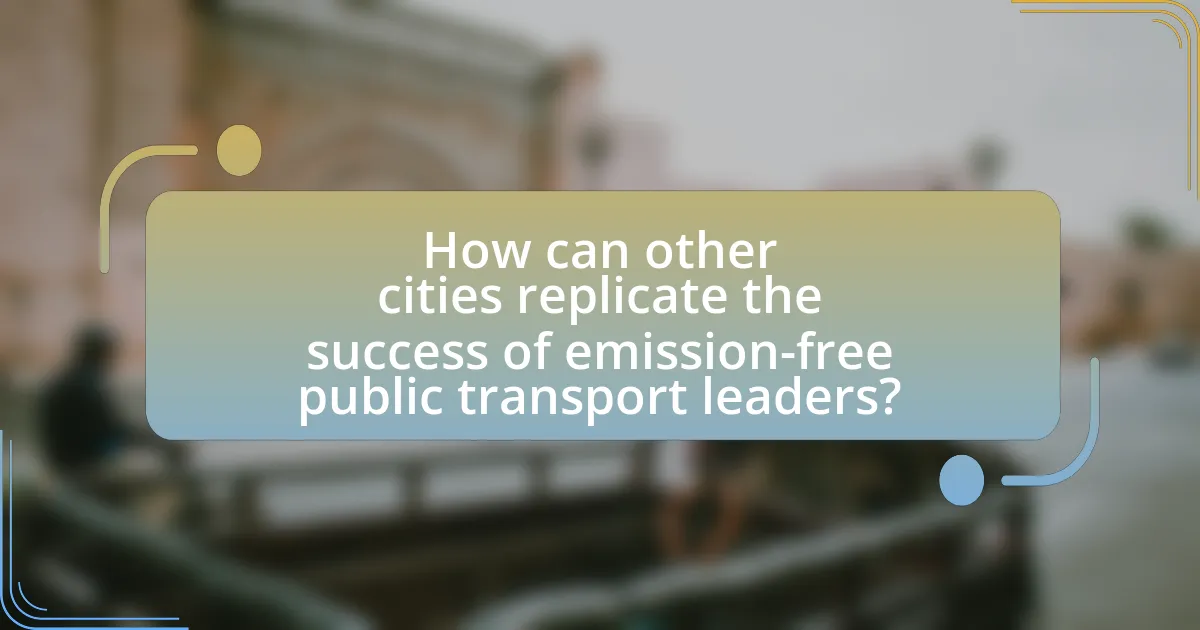
How can other cities replicate the success of emission-free public transport leaders?
Other cities can replicate the success of emission-free public transport leaders by adopting comprehensive policies that prioritize sustainable transportation, investing in electric vehicle infrastructure, and engaging the community in the transition process. For instance, cities like Oslo have implemented policies that include significant investments in electric buses and trams, resulting in a 50% reduction in emissions from public transport since 2019. Additionally, establishing partnerships with private companies for charging infrastructure and incentivizing the use of public transport through subsidies can further enhance the effectiveness of these initiatives. By analyzing successful case studies and tailoring strategies to local contexts, cities can effectively transition to emission-free public transport systems.
What best practices can be adopted from leading cities?
Leading cities adopt several best practices for emission-free public transport, including the implementation of electric bus fleets, investment in cycling infrastructure, and integration of multimodal transport systems. For instance, cities like Amsterdam and Copenhagen have successfully expanded their cycling networks, resulting in a significant increase in bike usage, which reduces reliance on motor vehicles. Additionally, Los Angeles has committed to transitioning its entire bus fleet to electric by 2030, showcasing a clear commitment to sustainability. Furthermore, cities such as Barcelona have integrated various transport modes, allowing seamless transfers between buses, trams, and metro systems, which enhances overall efficiency and encourages public transport use. These practices demonstrate effective strategies for reducing emissions and promoting sustainable urban mobility.
How can cities secure funding for emission-free transport projects?
Cities can secure funding for emission-free transport projects by leveraging a combination of government grants, public-private partnerships, and innovative financing mechanisms. For instance, the European Union has allocated billions of euros through programs like the Green Deal to support sustainable transport initiatives, which cities can apply for. Additionally, cities can engage with private sector stakeholders to co-fund projects, as seen in various successful collaborations that have resulted in shared investments in electric bus fleets. Furthermore, cities can explore green bonds, which are specifically designed to finance environmentally friendly projects, providing a viable funding source while attracting socially responsible investors.
What partnerships are essential for successful implementation of emission-free systems?
Successful implementation of emission-free systems requires partnerships between government entities, private sector companies, and research institutions. Government entities provide regulatory frameworks and funding, while private sector companies contribute technology and infrastructure. Research institutions offer data and innovation to enhance system efficiency. For example, cities like Oslo have partnered with electric vehicle manufacturers and local transit authorities to develop comprehensive charging infrastructure, demonstrating the effectiveness of collaborative efforts in achieving emission-free public transport.
What practical steps can cities take to transition to emission-free public transport?
Cities can transition to emission-free public transport by implementing electric bus fleets, investing in charging infrastructure, and promoting active transportation options. Electric bus fleets reduce greenhouse gas emissions significantly; for example, a study by the American Public Transportation Association found that electric buses can reduce emissions by up to 70% compared to diesel buses. Investing in charging infrastructure ensures that electric buses can operate efficiently, with cities like Los Angeles committing to install over 1,000 charging stations by 2028. Additionally, promoting active transportation, such as cycling and walking, complements public transport and reduces reliance on fossil fuels, as evidenced by cities like Amsterdam, where cycling accounts for 27% of all trips.
How can cities engage the community in the transition process?
Cities can engage the community in the transition process by implementing participatory planning initiatives that involve residents in decision-making. For example, cities like Amsterdam have successfully utilized workshops and public forums to gather input from citizens on sustainable transport options, ensuring that community needs and preferences shape the transition. Research indicates that such engagement not only fosters a sense of ownership among residents but also leads to higher acceptance and support for emission-free public transport initiatives, as evidenced by a study from the European Commission which found that community involvement increases project success rates by up to 30%.
What are the key metrics for measuring the success of emission-free public transport initiatives?
Key metrics for measuring the success of emission-free public transport initiatives include ridership levels, greenhouse gas emissions reduction, operational cost savings, and user satisfaction. Ridership levels indicate the effectiveness of the initiative in attracting users, while greenhouse gas emissions reduction quantifies the environmental impact, with successful initiatives often reporting significant decreases in emissions compared to traditional transport systems. Operational cost savings reflect the financial viability of emission-free technologies, as many cities have documented lower maintenance and fuel costs. User satisfaction is assessed through surveys and feedback, providing insights into the public’s acceptance and perceived benefits of the initiative. These metrics collectively offer a comprehensive view of the initiative’s success and areas for improvement.
